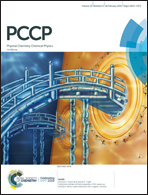A unique activation–promotion mechanism of the influenza B M2 proton channel uncovered by multiscale simulations†
Abstract
The influenza B M2 protein (BM2) forms an acid-activated proton channel that is important for the virus's lifecycle. Despite extensive research efforts, the detailed activation mechanism of the BM2 proton channel is often elusive. Herein a pH-regulated mechanism of the BM2TM domain has been systematically characterized using multiscale computer simulations, including classical molecular dynamics, constant pH molecular dynamics (CpHMD) and quantum mechanics/molecular mechanics (QM/MM) approaches. Our simulations reveal a pH-dependent conformational switch from the C-terminal closed to the C-terminal open conformers, and provide the free energy of conformational activation coupled to the titration of the His19 tetrad. Importantly, our results confirm the coupling titration between the His19 tetrad and His27 tetrad, and identify that the full-cationic state (His2744+) dominates at the low pH (the His19 tetrad at +2, +3 and +4 charge states). Our QM/MM simulations indicate that the second titratable histidine, His27, could further promote the BM2 acid activation and speed up proton dissociation from the HxxxW motif, thus facilitating proton conduction by BM2. Taken together, a unique “activation–promotion mechanism” about the BM2 proton channel is proposed, and these results may be helpful for the understanding of other similar proton channels and the development of BM2 inhibitors.



 Please wait while we load your content...
Please wait while we load your content...